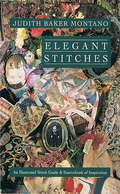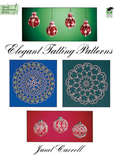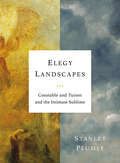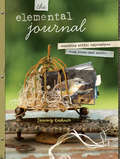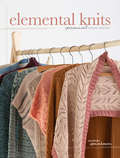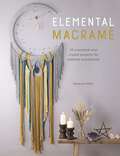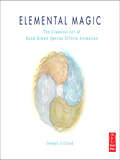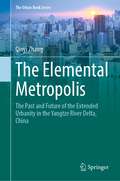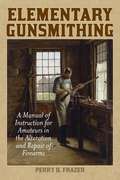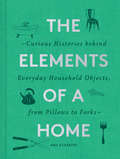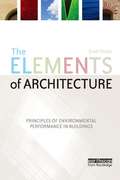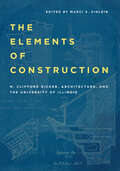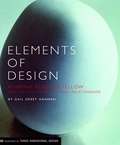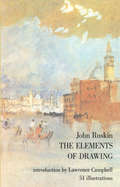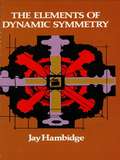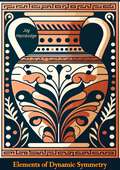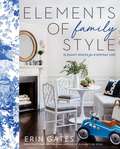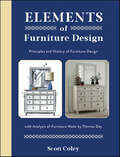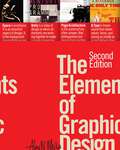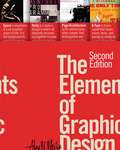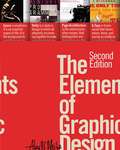- Table View
- List View
Elegant Stitches: An Illustrated Stitch Guide & Source Book of Inspiration
by Judith Baker MontanoThe renowned fiber artist shares a wealth of inspiration in this illustrated reference guide with 100s of stitches for needleworkers of all skill levels.Judith Baker Montano’s Elegant Stitches features all the step-by-step instructions and illustrations you’ll need to create your own embroidered masterpieces. This volume includes 117 embroidery stitches and more than 130 crazy quilt combination stitches to start your stitching adventure. Judith also offers in-depth instruction on silk ribbon stitches, free-form stitches, composite stitches, and even left-handed stitches.
Elegant Tatting Patterns
by Janet CarrollExperienced tatters in search of especially delicate and beautiful tatting projects need look no further than this outstanding collection of patterns. Master tatter and traditional artist Janet Carroll has compiled 44 designs -- some incorporating threads of two different colors as well as new and advanced techniques. With them, needlecrafters will be able to create an exceptional treasure chest of heirloom-quality doilies, Christmas tree ornaments, and much more.Clear instructions explain how to produce such lovely patterns as the delicate Ellipse, and Exquisite Crowning Touch, dainty edgings for throw pillows, cushion covers, pillow cases, tablecloths, napkins, handkerchiefs, collars, cuffs, and other domestic articles.Sure to add a special touch to linens and other fine fabrics, the lacy symmetry of these superb designs -- clearly photographed for each project -- will challenge intermediate and more advanced tatters.
Elegy for Theory
by D. N. RodowickRhetorically charged debates over theory have divided scholars of the humanities for decades. In Elegy for Theory, D. N. Rodowick steps back from well-rehearsed arguments pro and con to assess why theory has become such a deeply contested concept. Far from lobbying for a return to the "high theory" of the 1970s and 1980s, he calls for a vigorous dialogue on what should constitute a new, ethically inflected philosophy of the humanities. Rodowick develops an ambitiously cross-disciplinary critique of theory as an academic discourse, tracing its historical displacements from ancient concepts of theoria through late modern concepts of the aesthetic and into the twentieth century. The genealogy of theory, he argues, is constituted by two main lines of descent--one that goes back to philosophy and the other rooted instead in the history of positivism and the rise of the empirical sciences. Giving literature, philosophy, and aesthetics their due, Rodowick asserts that the mid-twentieth-century rise of theory within the academy cannot be understood apart from the emergence of cinema and visual studies. To ask the question, "What is cinema?" is to also open up in new ways the broader question of what is art. At a moment when university curriculums are everywhere being driven by scientism and market forces, Elegy for Theory advances a rigorous argument for the importance of the arts and humanities as transformative, self-renewing cultural legacies.
Elegy Landscapes: Constable And Turner And The Intimate Sublime
by Stanley PlumlyA sweeping look at the lives and work of two important English Romantic painters, from a Los Angeles Times Book Prize–winning author. Renowned poet Stanley Plumly, who has been praised for his “obsessive, intricate, intimate and brilliant” (Washington Post) nonfiction, explores immortality in art through the work of two impressive landscape artists: John Constable and J.M.W. Turner. How is it that this disparate pair will come to be regarded as Britain’s supreme landscape painters, precursors to Impressionism and Modernism? How did each painter’s life influence his work? Almost exact contemporaries, both legendary artists experience a life-changing tragedy—for Constable it is the long illness and death of his wife; for Turner, the death of his singular parent and supporter, his father. Their work will take on new power thereafter: Constable, his Hampstead cloud studies; Turner, his Venetian watercolors and oils. Seeking the transcendent aesthetic awe of the sublime and reeling from their personal anguish, these talented painters portrayed the terrible beauty of the natural world from an intimate, close-up perspective. Plumly studies the paintings against the pull of the artists’ lives, probing how each finds the sublime in different, though inherently connected, worlds. At once a meditation on the difficulties in achieving truly immortal works of art and an exploration of the relationship between artist and artwork, Elegy Landscapes takes a wide-angle look at the philosophy of the sublime.
Elemental Architecture: Temperaments of Sustainability
by Phillip James TabbElemental Architecture presents a new and refreshing approach to sustainable architectural practice. Going beyond the standard performance-based and quantitative sustainable measures, it incorporates a broader framework of considerations, including the more poetic and noetic possibilities of environmental design. The book is structured around the ancient Greek and medieval alchemists’ system of the Five Temperaments: fire, earth, air, water, and ether. Phillip James Tabb examines how these elements produce both positive and negative environmental forces which have an impact on architectural design – from drinking water and fresh air to torrential floods and tornados. He shows how responding to or enhancing these forces can help us to create a more sustainable, healthy, and purposeful architecture. To illustrate this, each chapter draws on seminal contemporary works of architecture, from Peter Zumthor’s Bruder-Klaus Field Chapel to Frank Lloyd Wright’s masterpiece at Fallingwater. These examples are accompanied by over a hundred high-quality illustrations. Expanding the discussion of sustainability to include phenomenological as well as qualitative considerations, Elemental Architecture is ideal for students and researchers with an interest in sustainable architecture and architectural theory.
The Elemental Journal: Composing Artful Expressions from Items Cast Aside
by Tammy KushnirCreate Expressive Books from Salvaged TreasuresRusty doorknobs, cardboard containers and plastic packaging may seem like trash to some, but through the creative mind, they are transformed into beautiful expressions - equally parts artful book and assemblage. The Elemental Journal will show you how to craft a wide variety of journals to hold your secrets or express your inner thoughts, and discover new ways to use wood, paper, fabric, plastic and metal in your art.Peek inside The Elemental Journal and you will find...15 stepped-out journal projects made from unusual materials and found objects, from tree bark to dismantled photo albums to tin boxes.Tips for seeking out materials for your journals in flea markets, garage sales, and in your own attic or trash can.Inspiring gallery projects from 9 contributing artists, including Susan Tuttle, Jen Osborn and Jill Berry.One artist's trash is another's treasure. Discover yours with The Elemental Journal.
Elemental Knits: A Perennial Knitwear Collection
by Courtney SpainhowerElemental Knits is for women who aspire to be ever stylish, more comfortable, and less wasteful. With knitwear designer Courtney Spainhower, you'll craft an appearance that truly reflects your spirit with a collection of 20 knitting patterns designed to enhance your wardrobe year-round. • Knit with intention, selecting patterns and fibers for their wearablity, versatility, and how they enhance your existing wardrobe. • 20 patterns explore a range of knitting techniques with features suited to each season--texture and cables for autumn, allover patterning for winter, garter and lace for spring, and colorful accents for summer. • Revel in gorgeous details that take these garments and accessories from functional to essential in a way that will have you wearing them year after year. Enrich your hand-knit wardrobe with intentional projects that will act as wardrobe staples for years to come with Elemental Knits.
Elemental Macramé: 20 macramé and crystal projects for balance and beauty
by Rebecca MillarCreate beautiful macrame projects that invoke the sacred elements of Earth, Air, Water, Fire and Spirit. The idea of classical elements' is common to many belief systems including Ancient Greek, Egyptian, Babylonian, Hinduism and Buddhism, as well as Chinese and Japanese philosophies. The five elements of the Pagan religion Wicca represent the five points of the pentagram, a powerful sacred symbol. No matter what your beliefs, paying attention to the forces of nature can bring a greater sense of spirituality and calm to your life, which is equally true of the craft of macrame, which like all handicrafts has proven benefits for wellbeing. This unique and beautiful book celebrates each of the Earth's sacred elements with projects that even beginners to macrame can tackle with ease. In nature, each element has its own specific properties, colours and stones associated with it, which these projects incorporate to dramatic effect. The 20 projects include mooncatchers, wall hangings, home accessories and jewellery, which all draw their inspiration from nature and the elements. Many of the projects have crystals incorporated into them, for the good vibrations and healing energy they bring. You'll also learn how to dip-dye macrame for wonderful ombre effects and work with a variety of different coloured cords to bring beauty and interest to your pieces. Make a tree of life hoop to connect with the earth, a mooncatcher to protect you during sleep, a hanging fruit bowl to feed and nourish you, and a plant hanger to purify your air. Make a necklace to bring out your inner goddess, a crystal suncatcher to capture your fire, or some coasters for your altar candles to sit on. With 20 projects to choose from you will find a whole host of ways to enjoy macrame in a new intentional, spiritual light. Author Rebecca Millar is best known as the creator of Vanir Creations, who has amassed a huge online following for her dreamy macrame hoops and moon catchers. Entirely self-taught, Rebecca now generously shares her secrets in this book, which demystifies the craft with simple explanations of the knots and techniques required.
Elemental Magic: The Art of Special Effects Animation
by Joseph GillandCreate amazing animated effects such as fiery blazes, rippling water, and magical transformations. Animation guru Joseph Gilland breaks down the world of special effects animation with clear step-by-step diagrams and explanations on how to create the amazing and compelling images you see on the big screen. 'Elemental Magic' is jam-packed with rich, original illustrations from the author himself which help explain and illuminate the technique, philosophy, and approach behind classical hand drawn animated effects and how to apply these skills to your digital projects.
Elemental Magic , Volume 2: The Technique of Special Effects Animation
by Joseph GillandDesign beautiful, professional-level animated effects with these detailed step-by-step tutorials from former Disney animator and animated effects expert Joseph Gilland. Filled with beautiful, full-color artwork, Elemental Magic, Volume II, breaks down the animated effect process from beginning to end-including booming explosions, gusting winds, magical incantations, and raging fires. He also breaks down the process of effects "clean-up," as well as timing and frame rates. The companion website includes real-time footage of the author lecturing as he animates the drawings from the book. In these videos, he elucidates the entire process from blank page to final animation. See it all come to life like never before. Throughout the book, Joseph refers to and includes examples from his own professional work from feature films such as Lilo & Stitch and Tarzan.
The Elemental Metropolis: The Past and Future of the Extended Urbanity in the Yangtze River Delta, China (The Urban Book Series)
by Qinyi ZhangThis book provides a multi-scale reading of the spatial “elements” in which the extensive urbanity in Yangtze River Delta is constructed, and from there an imagination of a new paradigm of urbanization. The urbanization in Yangtze River Delta today is in need of a new interpretation and paradigm. The delta is a territory with city cores but it also has vast dispersed urbanization where the agricultural and non-agricultural activities and spaces are mixed and interlinked, a desakota (McGee, 1991). This book attempts to answer a basic question: what is the desakota in the Yangtze River Delta made of? The research Horizontal Metropolis led by Prof. Paola Viganò at EPFL, Switzerland focuses on the form of the contemporary city – the fragmentary spatial condition and dispersed urbanity all over the world. The study on Yangtze River delta is part of its research frame.
Elementary Gunsmithing: A Manual of Instruction for Amateurs in the Alteration and Repair of Firearms
by Perry D. FrazerA beginner’s guide to the ins and outs of guncraftsmanship from a professional gunsmith.When it was first published in 1938, Elementary Gunsmithing was one of the few books of the time to address an amateur audience, among more advanced titles. With clear, engaging, and instructional prose, Frazer takes beginner firearm interest to the next level by talking the reader through the fundamentals of gunsmithing, such as what tools are necessary for the craft, how to solder and mount parts, and even how to conduct a fledgling gunsmithing business. He specifically addresses the "young man who likes working at the bench,” and similarly the book reflects the spirit of innovation, resourcefulness, and do-it-yourself work.While the book may not cover contemporary firearms, it offers a grandfatherly, old-school instructional vibe with accurate information about guns up to the 1940s. Frazer focuses on gunsmithing with ordinary hand tools at the work bench, rather than complicated machinery. These helpful tips and information, which are still applicable today, make Elementary Gunsmithing a useful, classic, and historically significant reference for both amateurs and budding gunsmithers keen on building a full-time business.Skyhorse Publishing is proud to publish a broad range of books for hunters and firearms enthusiasts. We publish books about shotguns, rifles, handguns, target shooting, gun collecting, self-defense, archery, ammunition, knives, gunsmithing, gun repair, and wilderness survival. We publish books on deer hunting, big game hunting, small game hunting, wing shooting, turkey hunting, deer stands, duck blinds, bowhunting, wing shooting, hunting dogs, and more. While not every title we publish becomes a New York Times bestseller or a national bestseller, we are committed to publishing books on subjects that are sometimes overlooked by other publishers and to authors whose work might not otherwise find a home.
The Elements of a Home: Curious Histories behind Everyday Household Objects, from Pillows to Forks
by Amy AzzaritoThe Elements of a Home reveals the fascinating stories behind more than 60 everyday household objects and furnishings. Brimming with amusing anecdotes and absorbing trivia, this captivating collection is a treasure trove of curiosities.With tales from the kitchen, the bedroom, and every room in between, these pages expose how napkins got their start as lumps of dough in ancient Greece, why forks were once seen as immoral tools of the devil, and how Plato devised one of the earliest alarm clocks using rocks and water—plus so much more.• A charming gift for anyone who loves history, design, or décor• Readers discover tales from every nook and cranny of a home. • Entries feature historical details from locations all over the world, including Europe, Asia, North America, and Africa. As a design historian and former managing editor of Design*Sponge, author Amy Azzarito has crafted an engaging, whimsical history of the household objects you've never thought twice about. The result is a fascinating book filled with tidbits from a wide range of cultures and places about the history of domestic luxury.• Filled with lovely illustrations by Alice Pattullo• Perfect as a housewarming or wedding gift, or for anyone who adores interior design, trivia, history, and unique facts• Great for those who enjoyed The Greatest Stories Never Told: 100 Tales from History to Astonish, Bewilder, and Stupefy by Rick Beyer, An Uncommon History of Common Things by Bethanne Patrick and John Thompson, Encyclopedia of the Exquisite: An Anecdotal History of Elegant Delights by Jessica Kerwin Jenkins
The Elements of Architecture: Principles of Environmental Performance in Buildings
by Scott DrakeThe Elements of Architecture is a clear and well structured introduction to sustainable architecture, which concentrates on general principles to make an accessible and comprehensive primer for undergraduate students. The author takes a fresh and logical approach, focusing on the way aspects of the built environment are experienced by the occupants and how that experience is interpreted in architectural design. He works through basic elements and senses (sun; heat; light; sound; air; water and fire) to explain and frame effective environmental architectural design - not only arguing that the buildings we inhabit should be viewed as extensions of our bodies that interact with and protect us from these elements, but also using this analogy to explain complex ideas in an accessible manner.
The Elements of Construction: N. Clifford Ricker, Architecture, and the University of Illinois
by N. Clifford RickerA pioneer of architecture education in the United States, N. Clifford Ricker notably taught with an emphasis on construction and shop practice in his teaching. Marci S. Uihlein edits and elaborates on The Elements of Construction, the text on building materials that Ricker wrote and used in his teaching, but never published. The book is a window into the expanding possibilities of the late nineteenth-century, as Ricker continually revised The Elements of Construction to keep up with advances taking place in architecture, materials, and construction technology. In addition to providing the full text, Uihlein and the contributors trace Ricker’s career and delve into his practice of teaching. Subject experts explore specific topics. Thomas Leslie surveys contemporary construction practices in Chicago. Tom F. Peters considers Ricker’s writings in the context of the time while Rachel Will looks at masonry know-how and testing. Donald Friedman examines the teaching of iron and steel construction. An illuminating look at a field and a legacy, The Elements of Construction rediscovers a figure that shaped the teaching of architecture and trained a generation that forever changed Chicago.
Elements of Design
by Gail Greet HannahA hands-on book design students and designers alike will welcome. Elements of Design is a tribute to an exceptional teacher and a study of the abstract visual relationships that were her lifelong pursuit. Rowena Reed Kiostellow taught industrial design at Pratt Institute for more than fifty years and the designers she trained-and the designers they're training today-have changed the face of American design. This succinct, instructive, invaluable book reconstructs the series of exercises that led Kostellow's students from the manipulation of simple forms to the creation of complex solutions to difficult design problems. It includes her exercises and commentary along with selected student solutions, and concludes with examples of work from former students who became leaders in the field, including such well-known figures as Tucker Viemeister, Ralph Applebaum, Ted Muehling, and many others.
The Elements of Drawing: In Three Letters To Beginners (Dover Art Instruction)
by John RuskinCan drawing -- sound, honest representation of the world as the eye sees it, not tricks with the pencil or a few "effects" -- be learned from a book? One of the most gifted draftsmen, who is also one of the greatest art critics and theorists of all time, answers that question with a decided "Yes." He is John Ruskin, the author of this book, a classic in art education as well as a highly effective text for the student and amateur today.The work is in three parts, cast in the form of letters to a student, successively covering "First Practice," "Sketching from Nature," and "Colour and Composition." Starting with the bare fundamentals (what kind of drawing pen to buy; shading a square evenly), and using the extremely practical method of exercises which the student performs from the very first, Ruskin instructs, advises, guides, counsels, and anticipates problems with sensitivity. The exercises become more difficult, developing greater and greater skills until Ruskin feels his reader is ready for watercolors and finally composition, which he treats in detail as to the laws of principality, repetition, continuity, curvature, radiation, contrast, interchange, consistency, and harmony. All along the way, Ruskin explains, in plain, clear language, the artistic and craftsmanlike reasons behind his practical advice -- underlying which, of course, is Ruskin's brilliant philosophy of honest, naturally observed art which has so much affected our aesthetic. Three full-page plates and 48 woodcuts and diagrams (the latter from drawings by the author) show the student what the text describes. An appendix devotes many pages to the art works which may be studied with profit.
The Elements of Dynamic Symmetry (Dover Art Instruction)
by Jay HambidgeIs design intuitive or is it consciously and methodically worked out? Are there basic rules governing design that, when learned, will facilitate the creative process? These questions have been asked by artists, art historians, and art critics throughout the ages.Convinced that design was not purely instinctive, Jay Hambidge (1867-1924) spent much of his life searching for the technical bases of design. He found his answer in dynamic symmetry, one of the most provocative and stimulating theories in art history. Hambidge's study of Greek art convinced him that the secret of the beauty of Greek design was in the conscious use of dynamic symmetry -- the law of natural design based upon the symmetry of growth in man and in plants. But Hambidge, who was not only a theoretician but also a practicing artist, did much more than analyze classical art and its principles of design: he worked out a series of root rectangles that the artist, using the simple mathematics supplied in this book, can easily follow and apply in his own work.Originally published as a series of lessons in Hambidge's magazine, The Diagonal, this engrossing book explains all the basic principles of dynamic symmetry. Part I sets forth the fundamental rectangles with their simple divisions based on the proportioning law found in nature; Part II explains compound rectangles, many of which were taken from or suggested by analysis of objects of Greek art. Whether read for its historical importance in art theory, for its illuminating insights into Greek art, or for its practical value to today's artists and commercial designers, The Elements of Dynamic Symmetry has much to offer anyone who is interested in the principle of design.
Elements of Dynamic Symmetry (Dover Art Instruction Ser.)
by Jay HambidgeUnlock the secrets of nature's inherent harmony with Jay Hambidge's seminal work, Elements of Dynamic Symmetry. This groundbreaking book introduces readers to the principles of dynamic symmetry, a system of proportion and design that underlies the natural world and has been used by artists, architects, and designers throughout history to create aesthetically pleasing and harmonious compositions.Jay Hambidge, a pioneer in the study of geometric proportion, presents a comprehensive exploration of dynamic symmetry, tracing its origins and applications across various fields. Through clear explanations, detailed diagrams, and insightful analysis, Hambidge demonstrates how these principles can be applied to achieve balance and beauty in art and design.Elements of Dynamic Symmetry delves into the mathematical foundations of this system, exploring the ratios and relationships that govern dynamic symmetry. Hambidge illustrates how these principles can be found in natural forms, from the spirals of shells to the branching of trees, and how they have been employed in the masterpieces of classical and modern art, from ancient Greek temples to Renaissance paintings.Elements of Dynamic Symmetry is an essential read for artists, architects, designers, and anyone interested in the intersection of art, mathematics, and nature. Hambidge's pioneering work continues to inspire and inform, offering timeless insights into the universal principles of beauty and harmony.Join Jay Hambidge on a journey through the elements of dynamic symmetry and discover how these principles can transform your understanding of design and aesthetics. This classic text remains a cornerstone in the study of proportion and a testament to the enduring power of geometric harmony in the creation of art.
Elements of Family Style: Elegant Spaces for Everyday Life
by Erin GatesNew York Times bestselling author and popular lifestyle blogger Erin Gates shares everything you need to know about designing a beautifully stylish—yet practical and functional—family home through candid advice, inspirational ideas, and lessons learned.Loved by her readers for her chic interior designs and frank and funny revelations about life behind the scenes of her picture-perfect blog, bestselling author and designer Erin Gates presents a new book about how to live stylishly amidst the chaos of daily family life. Throughout her career designing homes for families of all kinds all over the country, Erin has always maintained that living with children and pets does not mean that you have to forego nice things. This uniquely personal and practical guide will explain how to create a home that makes you proud and reflects your own style while also being durable, safe, and comfortable for children. It focuses on the spaces families share, those that are dedicated to the kids, and the oft-forgotten retreats for parents. Erin combines honest design advice and gorgeous inspirational photographs with engaging and intimate personal essays about life lessons learned the hard way while struggling with infertility and becoming a mother, managing a business, overseeing her own home renovation, and finding time for her marriage. She&’ll share how to store toys so that shared spaces don&’t look like a kindergarten, the expensive-looking fabrics that will stand up to a marauding toddler with sticky hands, nursery looks that go beyond blue and pink, and furniture that does not have to be stored during the baby-proofing years. She also showcases the work of other designers she loves who surround parents, children, and their pets with comfort and beauty. Like a best friend who has a knack for style and a taste for fun, Erin opens her front door and invites you into her life and all of its beautiful imperfection.
Elements of Furniture Design
by Scott ColeyA comprehensive look at the history, elements of construction, and all the steps in furniture design from an expert in the industry. Elements of Furniture Design is a resource of information gathered from 30 years of working as a professional furniture designer. These elements of design are essential, and there is no other resource where they are available in one place. The reader will gain a comprehensive knowledge of how furniture is designed, and can use this information to create new and exciting design concepts. This knowledge is provided in four sections: • A brief history and quick designer references (woods, veneers, wood joinery, comfort, architectural references, and drawing tools) • Illustrating furniture construction • Historic ornament used on furniture (molding, turning, carving) • The typical design process with a new client The work of cabinetmaker Thomas Day (a free man of color in the South in the mid-1800s) is used to tie the story together, and the reader will learn trade secrets of furniture design that have been lost to outsourcing and offshore manufacture.
The Elements of Graphic Design
by Alex W. WhiteThis very popular design book has been wholly revised and expanded to feature a new dimension of inspiring and counterintuitive ideas to thinking about graphic design relationships. The Elements of Graphic Design, Second Edition is now in full color in a larger, 8 x 10-inch trim size, and contains 40 percent more content and over 750 images to enhance and better clarify the concepts in this thought-provoking resource. The second edition also includes a new section on Web design; new discussions of modularity, framing, motion and time, rules of randomness, and numerous quotes supported by images and biographies. This pioneering work provides designers, art directors, and students--regardless of experience--with a unique approach to successful design. Veteran designer and educator Alex. W. White has assembled a wealth of information and examples in his exploration of what makes visual design stunning and easy to read. Readers will discover White's four elements of graphic design, including how to: define and reveal dominant images, words, and concepts; use scale, color, and position to guide the viewer through levels of importance; employ white space as a significant component of design and not merely as background; and use display and text type for maximum comprehension and value to the reader. Offering a new way to think about and use the four design elements, this book is certain to inspire better design.
The Elements of Graphic Design
by Alex W. WhiteThis very popular design book has been wholly revised and expanded to feature a new dimension of inspiring and counterintuitive ideas to thinking about graphic design relationships. The Elements of Graphic Design, Second Edition is now in full color in a larger, 8 x 10-inch trim size, and contains 40 percent more content and over 750 images to enhance and better clarify the concepts in this thought-provoking resource. The second edition also includes a new section on Web design; new discussions of modularity, framing, motion and time, rules of randomness, and numerous quotes supported by images and biographies. This pioneering work provides designers, art directors, and students--regardless of experience--with a unique approach to successful design. Veteran designer and educator Alex. W. White has assembled a wealth of information and examples in his exploration of what makes visual design stunning and easy to read. Readers will discover White's four elements of graphic design, including how to: define and reveal dominant images, words, and concepts; use scale, color, and position to guide the viewer through levels of importance; employ white space as a significant component of design and not merely as background; and use display and text type for maximum comprehension and value to the reader. Offering a new way to think about and use the four design elements, this book is certain to inspire better design.
The Elements of Graphic Design: Space, Unity, Page Architecture, and Type (2nd Edition)
by Alex W. WhiteThis pioneering work has been wholly revised and expanded to feature a new dimension of inspiring and counter-intuitive ideas to thinking about graphic design relationships and provides designers, art directors, and students--regardless of experience--with a unique approach to successful design. The second edition includes a new section on Web design; new discussions of modularity, framing, motion and time, rules of randomness, and numerous quotes supported by images and biographies.
Elements of Japanese Design
by Boye Lafayette De MenteElements of Japanese Design introduces 80 key concepts in Japanese design in a readable and accessible short-entry format. Including a brief explanation and examples of every aspect of Japanese design-from Wah (Harmony) to Kaizen (Continuous Improvement), from Mushin (the Empty Mind) to Mujo (Incompleteness).
